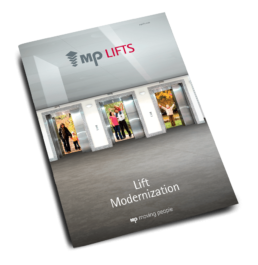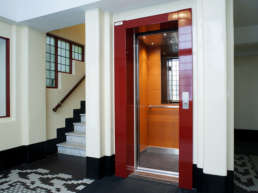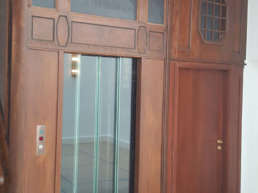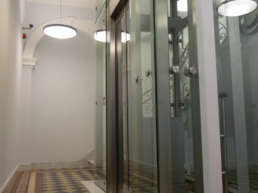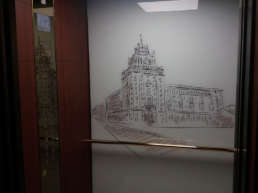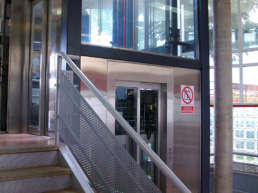Reasons to take action:
Safety / Non-compliance With Standards
Failure to comply with standards means compromising on safety.
The main causes of accidents include:
- Uncontrolled car movement.
- Lack of a car door.
- Overload.
- Lack of ascending car overspeed protection.
- A faulty overspeed governor or safety gear.
- Lack of a door sensor.
- Poor levelling accuracy.
- Lack of an alarm system.
- Lack of a rescue system.
- Lack of an evacuation mode for use in the event of a fire.
- If your lift is not monitored 24 hours a day, 365 days a year, in the event of a fault, passengers will be trapped until someone notifies the maintenance company.
Energy Efficiency
-
The car is permanently lit using incandescent, fluorescent or halogen lamps,
as opposed to LEDs. - Geared machines with one or two speeds.
-
The lift’s electrical equipment is permanently on, 24 hours a day, 365
days a year. - Lack of a regenerative system which makes use of the energy generated
when the lift brakes.
Comfort
- Noise from the machine or hydraulic power unit.
- Vibrations in the car.
- Long travel and waiting times.
- The doors appearing to take a long time to open.
- The lift appearing to take a long time to start moving.
Connectivity
-
- A connected lift allowed faults to be pre-empted by analysing its data. This allows the maintenance service to undertake preventive repairs, which are less costly and take less time to complete than faults that occur without warning. Preventive maintenance also improves the overall service life of a lift.
- The maintenance service is immediately notified when alarms are activated. As such, when a fault occurs or passengers become trapped, maintenance personnel are notified straight away, often before users are even aware of the issue.
- Faults can be repaired remotely. Technicians receive information on problems that occur as well as the components affected, meaning they are able to carry out any necessary repair work quicker.
- Where equipment has not been permanently damaged, having a connected lift allows the fault to be fixed remotely and the lift put back into service straight away.
- Contactless destination selection: users can call the lift from their mobile phone using the Callmylift app, creating a touch-free experience.
- Having a connected lift gives you access to a whole host of useful information on your lift, such as its status, as well as data relating to usage and availability, via an app.
Accessibility
Problems for users with reduced mobility:
- Poor levelling accuracy (space between the floor of the lift and the landing).
- Hinged doors, which have to be opened manually.
- Narrow doors and cars, which do not allow those in a wheelchair to use the lift.
- The lift cannot be accessed from street level (stairs must be used to reach it).
Problems for users who are blind ciegas orpoca visually impaired:
- Operating panels and buttons with no colour contrast, making them difficult
to see. - Buttons without raised characters or Braille.
- The absence of audible signals, meaning blind users are unaware of where
the lift is, if it is going up or down, or if the doors are opening or closing.
Problems for deaf users:
- Lack of an audio induction loop to help deaf passengers wearing a hearing aid.
- An alarm button that does not light up when pressed.
Others:
- XL buttons for those with motor difficulties.
Reliability
- Irregular behaviour.
- Regular faults.
- Difficulty obtaining spare parts needed for repairs.
- A feeling a fault could occur at any time and a fear of using the lift.
When any of the above happens, it means your lift is no longer reliable.
A lift’s electrical equipment always ages quicker than the rest of its components, due to wear caused by the constant activation and deactivation of contacts and electrical signals. An old electrical installation causes continuous faults and requires parts to be regularly replaced.
What’s more, an old machine that produces noise and vibrations can experience
a major fault at any time.
Aesthetics
- A car with outdated walls and floor, which make it look worn, dirty or old.
- Operating panels with LED displays or outdated illuminated buttons.
- Ceilings with fluorescent lamps.
- Outdated material and technology.
Special Requirements
- Ready for use by firefighters.
- Protection against seismic movements.
- Protection against vandalismo.
-
-
Safety / Non-compliance With Standards
Failure to comply with standards means compromising on safety.
The main causes of accidents include:
- Uncontrolled car movement.
- Lack of a car door.
- Overload.
- Lack of ascending car overspeed protection.
- A faulty overspeed governor or safety gear.
- Lack of a door sensor.
- Poor levelling accuracy.
- Lack of an alarm system.
- Lack of a rescue system.
- Lack of an evacuation mode for use in the event of a fire.
- If your lift is not monitored 24 hours a day, 365 days a year, in the event of a fault, passengers will be trapped until someone notifies the maintenance company.
-
-
Energy Efficiency
-
The car is permanently lit using incandescent, fluorescent or halogen lamps,
as opposed to LEDs. - Geared machines with one or two speeds.
-
The lift’s electrical equipment is permanently on, 24 hours a day, 365
days a year. - Lack of a regenerative system which makes use of the energy generated
when the lift brakes.
-
-
-
Comfort
- Noise from the machine or hydraulic power unit.
- Vibrations in the car.
- Long travel and waiting times.
- The doors appearing to take a long time to open.
- The lift appearing to take a long time to start moving.
-
-
Connectivity
-
- A connected lift allowed faults to be pre-empted by analysing its data. This allows the maintenance service to undertake preventive repairs, which are less costly and take less time to complete than faults that occur without warning. Preventive maintenance also improves the overall service life of a lift.
- The maintenance service is immediately notified when alarms are activated. As such, when a fault occurs or passengers become trapped, maintenance personnel are notified straight away, often before users are even aware of the issue.
- Faults can be repaired remotely. Technicians receive information on problems that occur as well as the components affected, meaning they are able to carry out any necessary repair work quicker.
- Where equipment has not been permanently damaged, having a connected lift allows the fault to be fixed remotely and the lift put back into service straight away.
- Contactless destination selection: users can call the lift from their mobile phone using the Callmylift app, creating a touch-free experience.
- Having a connected lift gives you access to a whole host of useful information on your lift, such as its status, as well as data relating to usage and availability, via an app.
-
-
-
Accessibility
Problems for users with reduced mobility:
- Poor levelling accuracy (space between the floor of the lift and the landing).
- Hinged doors, which have to be opened manually.
- Narrow doors and cars, which do not allow those in a wheelchair to use the lift.
- The lift cannot be accessed from street level (stairs must be used to reach it).
Problems for users who are blind ciegas orpoca visually impaired:
- Operating panels and buttons with no colour contrast, making them difficult
to see. - Buttons without raised characters or Braille.
- The absence of audible signals, meaning blind users are unaware of where
the lift is, if it is going up or down, or if the doors are opening or closing.
Problems for deaf users:
- Lack of an audio induction loop to help deaf passengers wearing a hearing aid.
- An alarm button that does not light up when pressed.
Others:
- XL buttons for those with motor difficulties.
-
-
Reliability
- Irregular behaviour.
- Regular faults.
- Difficulty obtaining spare parts needed for repairs.
- A feeling a fault could occur at any time and a fear of using the lift.
When any of the above happens, it means your lift is no longer reliable.
A lift’s electrical equipment always ages quicker than the rest of its components, due to wear caused by the constant activation and deactivation of contacts and electrical signals. An old electrical installation causes continuous faults and requires parts to be regularly replaced.
What’s more, an old machine that produces noise and vibrations can experience
a major fault at any time. -
-
Aesthetics
- A car with outdated walls and floor, which make it look worn, dirty or old.
- Operating panels with LED displays or outdated illuminated buttons.
- Ceilings with fluorescent lamps.
- Outdated material and technology.
-
-
Special Requirements
- Ready for use by firefighters.
- Protection against seismic movements.
- Protection against vandalismo.
Get to know
your lift
Modernisation
